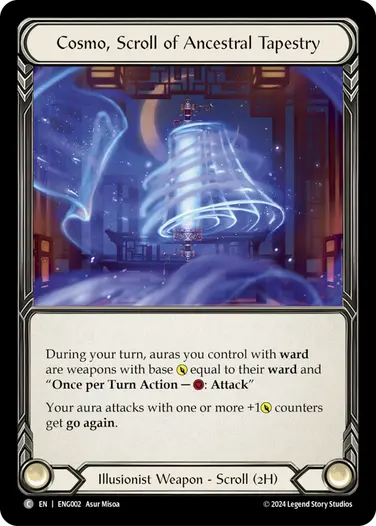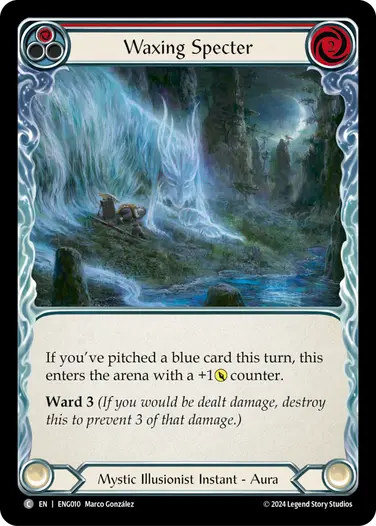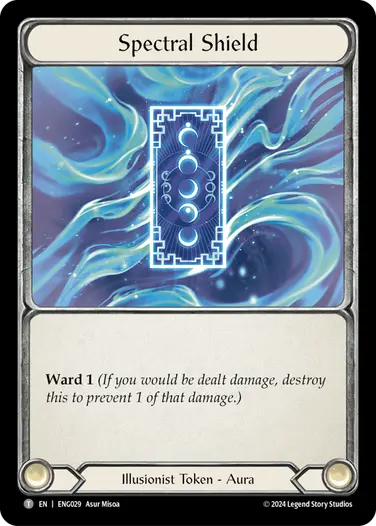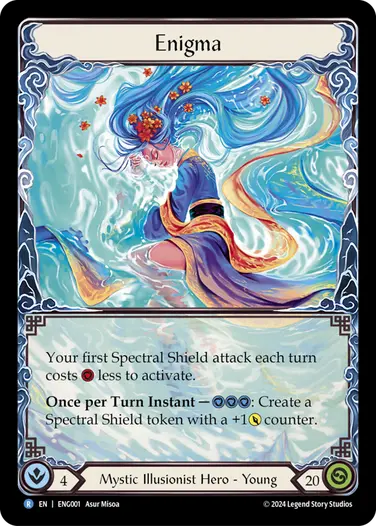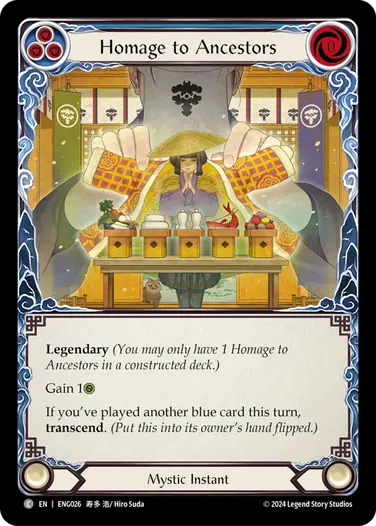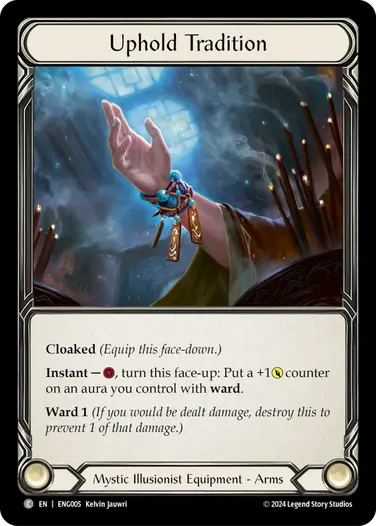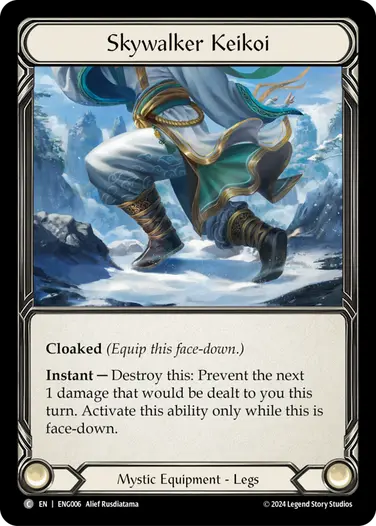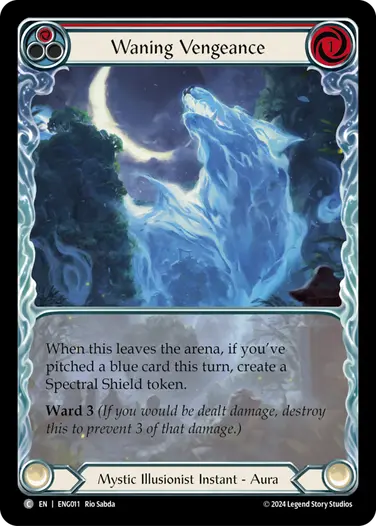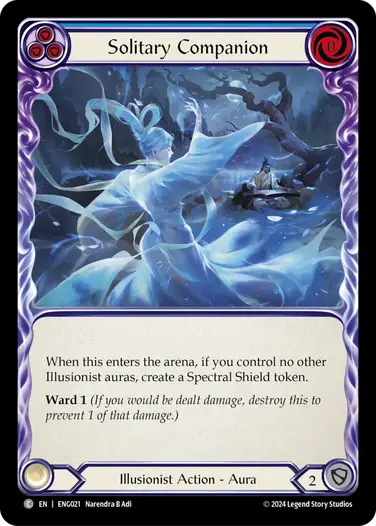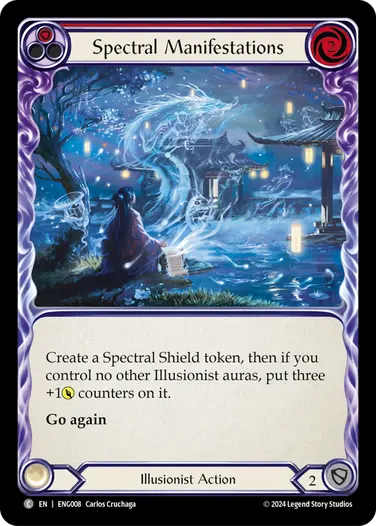"As my memories start to fade, the moonlight carries me home. To a place where sky meets water, where the cycle begins anew."
-Enigma
Enigma is a Mystic Illusionist who wards off danger with spectral auras. She carries centuries-old tales and traditions within her ancestral tapestry, an ever-changing mystery like the waxing and waning of the moon.

How to play Enigma
Enigma is a very complex deck that will likely take some time to learn and understand. She creates auras, which when played stay in the arena until something makes them leave. All of Enigma’s auras have the keyword ward, which means when you would take damage, instead you destroy the aura and prevent an amount equal to the ward listed on the card. If you have multiple auras with ward, you can choose the order in which you destroy them. Figuring out which auras to keep and which to let go is key to Enigma’s strategy.
What makes Enigma a complicated deck is her large number of instant cards, which can be played on either player’s turn without using an action point. With each hand you will need to work out if it’s better to play your instants on your opponent’s turn when they can prevent damage, or whether it’s better to play them on your own turn when they can’t be destroyed. This complexity is also one of Enigma’s greatest strengths, as it allows her a great deal of flexibility with her decisions.
Enigma’s signature weapon, Cosmo, Scroll of Ancestral Tapestry, allows you to attack with your auras at the cost of one resource each. The base damage each aura deals is equal to its ward, plus any +1 counters that have been placed on it.
When you play a card that places +1 counters on an aura (usually marked with a dice), the aura gets an attack bonus, and Cosmo will also give it go again so you can then attack with something else. +1 counters do not change the amount of damage prevented by ward.
For example, you could pitch a blue to play Waxing Specter, it would gain a +1 counter, then you could spend your remaining resource to attack with it for a total of 4 damage, with go again. When your opponent attacks you back, if you don’t defend, Waxing Specter will be destroyed and prevent 3 damage.
Many of Enigma’s cards create Spectral Shields. These are token auras that have ward 1. When they’re destroyed they go back to your token pile instead of the graveyard. Enigma’s hero ability makes your first Spectral Shield attack each turn free, so it’s always worth trying to keep one floating around to attack with.
Time to Transcend!
As a Mystic hero, Enigma has access to powerful instants that transcend when you have played another blue card this turn. Playing a blue instant, then activating your Mystic instant is a strong way to transcend with Enigma. Flip the card onto its Inner Chi face and put it back into your hand. You can now pitch your Inner Chi like you would any other card, but it can also pay for Enigma’s hero ability.
Enigma’s ability to create Spectral Shields with +1 counters is incredibly useful in many situations. Sometimes you will want to use it on the opponent’s turn to prevent damage, sometimes you will want to use it on your own turn to push damage. Remember that you can activate her ability once your opponent is out of action points but before their turn ends to ensure your Spectral Shield isn’t destroyed.
At the end of each game, remember to de-chi your deck, flipping your Inner Chi cards back to their regular Mystic instant face.
Armed to the Teeth
All of Enigma’s equipment are cloaked, which means they begin the game face down. These equipment do not do anything until you flip them face up. Heirloom of Rabbit Hide can be flipped up at the start of your turn when you have 1 life, preventing up to 4 damage on the following turn. This is a huge advantage if you’re planning on playing another aura you want to keep around.
Skywalker Keikoi can be used any time you want to prevent 1 damage, but the other two equipment must be used with a little more caution. Both require one resource to flip face up, which is great if you are pitching a single blue to pay for another card on the same turn. While face up they have ward, which can soak up damage that would otherwise destroy your auras.
Using your equipment at the right moment is crucial, whether it’s in response to an attack reaction, preventing smaller attacks by pitching a card that can’t defend, or even placing a +1 counter on your attacking aura to give it go again when your opponent has already defended thinking your turn is over.
How to win with Enigma
Building a massive army of auras to overwhelm the opponent is a surefire way to win, but it’s incredibly difficult to do so when you’re facing multiple small attacks each turn that threaten to wipe away everything you’ve built. A good way to get into the flow of playing Enigma is with the Waxing/Waning method: Play an aura on your own turn, attack with it, let it die on your opponent’s turn, then play a new one on your next turn. Soon you will start to find windows where it makes sense to play cards on your opponent’s turn in order to keep your more valuable auras around.
Unlike other Illusionists in Flesh and Blood, Enigma is usually happy for her auras to be wiped out each turn. Many cards in her deck will give you a bonus effect if you control no other Illusionist auras when they are played. This makes it very easy to rebuild from nothing, and over the course of the game you will start to see your opponent’s life total being chipped away, while ward keeps your own life total high.
When the gap between life totals is high enough, you can comfortably take damage to play a huge turn in order to force your opponent to start defending. Once the opponent is defending it will be extremely difficult for them to remove your auras. Now you can start pitching your Inner Chis over and over, building up enough Spectral Shield attacks to close out the game.
Remember to count each aura for what it’s worth both as an attack and as a defense. The easiest way to lose a game with Enigma is to overcommit to protecting auras you are inevitably going to lose. Try to think about what your opponent might do next, and whether you can afford to defend heavily and swing back with a single aura, or whether it’s time to accept that you’re losing the auras and start rebuilding next turn.
An easy way to remember the different cards in your deck is by the card types and the bonus effects they offer. Regular Illusionist cards are mostly actions you can only play on your own turn, and will give you a bonus if you control no other Illusionist auras when they are played. Mystic Illusionist cards are mostly instants you can play on either player’s turn, and will give you a bonus if you have pitched a blue this turn.
